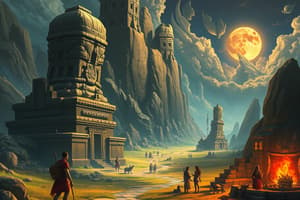Podcast
Questions and Answers
What was the primary mode of subsistence during the Paleolithic Age?
What was the primary mode of subsistence during the Paleolithic Age?
- Trading and commerce
- Hunting and gathering (correct)
- Agriculture and herding
- Fishing and foraging
Which of the following materials were used to make tools during the Paleolithic Age?
Which of the following materials were used to make tools during the Paleolithic Age?
- Copper and gold
- Bronze and iron
- Stone and natural materials (correct)
- Wood and pottery
What was the primary transition that occurred during the Mesolithic Age?
What was the primary transition that occurred during the Mesolithic Age?
- The invention of written language
- The emergence of organized states and empires
- The decline of hunting and gathering societies
- The development of agriculture and herding (correct)
Where did people begin to settle during the Mesolithic Age?
Where did people begin to settle during the Mesolithic Age?
Which of the following developments occurred during the Neolithic Age?
Which of the following developments occurred during the Neolithic Age?
What marked the end of the Neolithic Age?
What marked the end of the Neolithic Age?
What was the primary mode of subsistence during the Paleolithic Age?
What was the primary mode of subsistence during the Paleolithic Age?
Which of the following was a significant development during the Neolithic Age?
Which of the following was a significant development during the Neolithic Age?
What was a major shift that occurred with the emergence of states?
What was a major shift that occurred with the emergence of states?
Which region is considered the birthplace of the first civilizations?
Which region is considered the birthplace of the first civilizations?
What was a characteristic of the early societies that emerged with the formation of states?
What was a characteristic of the early societies that emerged with the formation of states?
Which statement best describes the transition from prehistoric to historic times?
Which statement best describes the transition from prehistoric to historic times?
Flashcards are hidden until you start studying
Study Notes
Prehistoric Ages and Emergence of States
Prehistory refers to the time before written records were kept, spanning from approximately 5 million years ago until the beginning of recorded history. This era is divided into several distinct periods characterized by significant changes in human culture and society.
Paleolithic Age
The Paleolithic Period, also known as the Old Stone Age, lasted from around 2.6 million to 10,000 BCE. During this period, early humans lived as hunter-gatherers, relying on hunting, fishing, and gathering wild plants for food. They used stone tools and clothing made from natural materials such as animal skins and plant fibers. The Paleolithic Age ended with the development of agriculture and the transition to settled communities during the Neolithic Age.
Mesolithic Age
The Mesolithic Age, or Middle Stone Age, occurred after the end of the last ice age, between 10,000 and 5,000 BCE. It marked the transition from hunting and gathering to farming and herding. People began to settle along rivers and coasts where they could catch fish and gather shellfish. They continued to make stone tools but started to experiment with pottery and other new materials. The Mesolithic Age was a time of great change as people adapted to changing environments and began to establish permanent settlements.
Neolithic Age
The Neolithic Period, or New Stone Age, started around 10,000 BCE and continued until the Bronze Age, which began around 3300 BCE. During this period, humans shifted from nomadic hunting and gathering to settled agricultural communities. Grains like wheat and barley were domesticated, allowing people to grow their own food instead of having to rely solely on hunting and gathering. This led to the development of permanent settlements, which eventually grew into small towns and cities.
Emergence of States
The emergence of states marks a major shift in human civilization, moving away from small, local groups towards larger, more complex societies. The first civilizations emerged in ancient Sumeria, located in present-day Iraq, around 4000 BCE. These early societies were based on agriculture, with people living together in large villages or towns. Over time, these communities developed specialized labor, social hierarchy, and formal institutions, leading to the formation of city-states and kingdoms.
In conclusion, prehistoric ages represent a fascinating period of human evolution, covering millions of years of adaptation and innovation. From the simple life of early man during the Paleolithic Age to the establishment of settled communities during the Neolithic Age and the emergence of complex societies in the form of states, this era saw humanity's transition from a small, wandering species to a civilization capable of building great cities and empires.
Studying That Suits You
Use AI to generate personalized quizzes and flashcards to suit your learning preferences.




